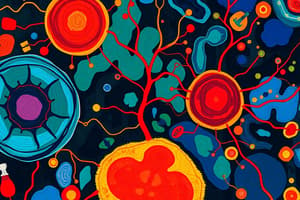Podcast
Questions and Answers
What initiates the process of cell signaling?
What initiates the process of cell signaling?
- Signal transduction process
- Response by the cell
- Synthesis and release of signaling molecules (correct)
- Reception of information by target cells
What is the role of a ligand in cell signaling?
What is the role of a ligand in cell signaling?
- It transports signals through the cytoplasm.
- It binds to specific receptors to form a larger complex. (correct)
- It amplifies the response of the target cell.
- It directly causes changes in gene expression.
What is the outcome of signal transduction in a cell?
What is the outcome of signal transduction in a cell?
- It transports signaling molecules to neighboring cells.
- It enhances the binding of ligands to receptors.
- It synthesizes more signaling molecules.
- It causes a change in cell activity or behavior. (correct)
Which of the following processes is NOT directly involved in cell signaling?
Which of the following processes is NOT directly involved in cell signaling?
What is one consequence of errors in cellular information processing?
What is one consequence of errors in cellular information processing?
What is the primary characteristic that enables a signaling molecule to bind to a receptor?
What is the primary characteristic that enables a signaling molecule to bind to a receptor?
Which type of receptors deals with hydrophilic signaling molecules?
Which type of receptors deals with hydrophilic signaling molecules?
What distinguishes G protein–linked receptors from other receptor types?
What distinguishes G protein–linked receptors from other receptor types?
What occurs when a signaling molecule binds to an ion channel–linked receptor?
What occurs when a signaling molecule binds to an ion channel–linked receptor?
In which condition can a cell produce different receptors?
In which condition can a cell produce different receptors?
What does a ligand refer to in the context of receptors?
What does a ligand refer to in the context of receptors?
Which receptor type has a tail extending into the cytosol that binds G proteins?
Which receptor type has a tail extending into the cytosol that binds G proteins?
What role do local regulators play in cell signaling?
What role do local regulators play in cell signaling?
Which of the following statements about neurotransmitters is correct?
Which of the following statements about neurotransmitters is correct?
What is the main function of hormones in cell signaling?
What is the main function of hormones in cell signaling?
How do signaling molecules ensure specificity in the reception process?
How do signaling molecules ensure specificity in the reception process?
Which of the following is considered a type of local regulator?
Which of the following is considered a type of local regulator?
Which of these processes is NOT a response induced by signaling molecules?
Which of these processes is NOT a response induced by signaling molecules?
What type of signaling molecule is histamine classified as?
What type of signaling molecule is histamine classified as?
What is the primary mode of transport for hormones to reach their target cells?
What is the primary mode of transport for hormones to reach their target cells?
Flashcards
Cell Signaling
Cell Signaling
The process by which cells communicate with each other.
Ligand
Ligand
A molecule that binds to a specific receptor on a cell, initiating a signaling pathway.
Signal Transduction
Signal Transduction
The process by which a cell converts an external signal into an internal one, triggering a cellular response.
Cellular Response
Cellular Response
Signup and view all the flashcards
Signaling Pathway
Signaling Pathway
Signup and view all the flashcards
Neurotransmitters
Neurotransmitters
Signup and view all the flashcards
Local Regulators
Local Regulators
Signup and view all the flashcards
Hormones
Hormones
Signup and view all the flashcards
Reception
Reception
Signup and view all the flashcards
Response
Response
Signup and view all the flashcards
Specificity in Reception
Specificity in Reception
Signup and view all the flashcards
Signal Transduction Cascade
Signal Transduction Cascade
Signup and view all the flashcards
Receptors
Receptors
Signup and view all the flashcards
Specificity of Receptors
Specificity of Receptors
Signup and view all the flashcards
Cell-Specific Receptors
Cell-Specific Receptors
Signup and view all the flashcards
Dynamic Receptor Expression
Dynamic Receptor Expression
Signup and view all the flashcards
Hydrophilic Signaling
Hydrophilic Signaling
Signup and view all the flashcards
Hydrophobic Signaling
Hydrophobic Signaling
Signup and view all the flashcards
Study Notes
Cell Communication
- Cells in multicellular organisms constantly communicate to maintain homeostasis.
- Many mechanisms exist for cell-to-cell communication, including electrical and chemical signaling.
- Organisms signal other members of their species using chemical signals.
- Bacteria, for instance, release signals that diffuse, increasing in concentration as the population grows.
Cell Signaling
- Cell signaling refers to the mechanisms cells use to communicate.
- It's part of a complex system governing cellular activities and coordinating actions.
- The ability of cells to respond to their microenvironment is essential for development, repair, and immunity, as well as homeostasis.
- Errors in cellular information processing can lead to diseases like cancer, autoimmunity, and diabetes.
- Understanding cell signaling can help treat diseases effectively.
Learning Objective 1
- Clarify the sequence of events in cell signaling.
Cell Signaling (Detailed)
-
1. Synthesis, release, transport of signaling molecules: Neurotransmitters, hormones, and other signaling molecules involved.
-
Ligand: An ion, molecule, or group that binds to another chemical entity forming a complex.
-
2. Reception of information by target cells: Cells capable of responding to the signal.
-
3. Signal transduction: The conversion of an extracellular signal into an intracellular signal, causing a change in the cell.
-
4. Response by the cell: The cell's reaction to the intracellular signal, illustrated with insulin promoting glucose uptake.
Cell Signaling (Diagram)
- Receptors, large proteins or glycoproteins, bind to signaling molecules.
- Signal transduction involves a chain reaction involving proteins and enzymes.
- This sequence leads to a cellular response.
Key Concepts
- Cells use chemical compounds like neurotransmitters, hormones, and other regulatory molecules to signal one another.
Learning Objective 2
- Detail three types of signaling molecules: local regulators, neurotransmitters, and hormones.
Local Regulators
- Paracrine regulation: Signaling molecules released by cells diffuse to act on nearby cells.
- Examples include histamine involved in allergic reactions, growth factors promoting cell division, prostaglandins affecting smooth muscle contraction, and nitric oxide relaxing smooth muscle in blood vessels.
Neurotransmitters
- Chemical signals released by neurons (nerve cells) for communication across synapses.
Hormones
- Chemical messengers in both plants and animals.
- Secreted by endocrine glands in animals.
- Transported through the bloodstream to target cells.
Key Concepts
- A signaling molecule binds to a receptor molecule on the cell surface or within the target cell.
Learning Objective 3
- Explain the factors contributing to specific reception mechanisms.
Receptors
-
Receptors are large proteins or glycoproteins binding with signaling molecules.
-
A signaling molecule binding to a receptor is a ligand.
-
Receptors have specific shapes, only matching signal molecules affect a cell.
-
The same cell can have different receptors at various stages in different environments or conditions.
-
Hydrophilic (water-soluble) signaling molecules cannot pass through the membrane and bind to receptors on the surface.
-
Hydrophobic (lipid-soluble) signaling molecules pass through the membrane and bind to receptors within the cytosol or the nucleus .
Learning Objectives 4 & 5
- Compare and contrast the different types of receptors on cell surfaces: ion channel-linked, G protein-linked, enzyme-linked, and intracellular receptors.
Ion Channel-Linked Receptor
- Signaling molecule binds, causing the ion channel to open or close.
- Conversion of chemical signals to electrical signals.
G Protein-Linked Receptor
- Transmembrane proteins linking signal molecules to signal transduction pathways.
- The receptor's tail extends into the cytosol, acting as a binding site for G proteins.
- G proteins are a family of transmembrane proteins looping through the membrane multiple times.
- Ligand binding to the receptor causes GDP to be replaced with GTP activating the G protein.
- Activated G protein triggers signal transduction, activates enzymes, and modifies cell function.
Enzyme-Linked Receptor
- Functions directly as enzymes or links to enzymes.
- Contains a binding site outside and inside the cell membrane.
- Tyrosine kinase is a common example (acts on tyrosine amino acid).
- Signal molecules binding dimerize receptors, allowing tyrosine kinase to phosphorylate neighboring receptors.
Intracellular Receptors
- Located in the cytosol or nucleus.
- Ligands are small, hydrophobic molecules that diffuse through the plasma membrane.
- Steroid hormones combine with intracellular nuclear receptors.
- These receptors act as transcription factors, activating or repressing specific genes, leading to altered cellular activity.
Cells Regulate Reception
- Cells control receptor numbers through synthesis or degradation, affecting sensitivity to hormones.
- Down-regulation: reducing receptor numbers when hormones are excessive.
- Up-regulation: increasing receptors to amplify response when hormone levels are low.
Key Concepts
- In signal transduction, a receptor molecule transforms an extracellular signal into an intracellular signal triggering cellular changes.
Studying That Suits You
Use AI to generate personalized quizzes and flashcards to suit your learning preferences.



